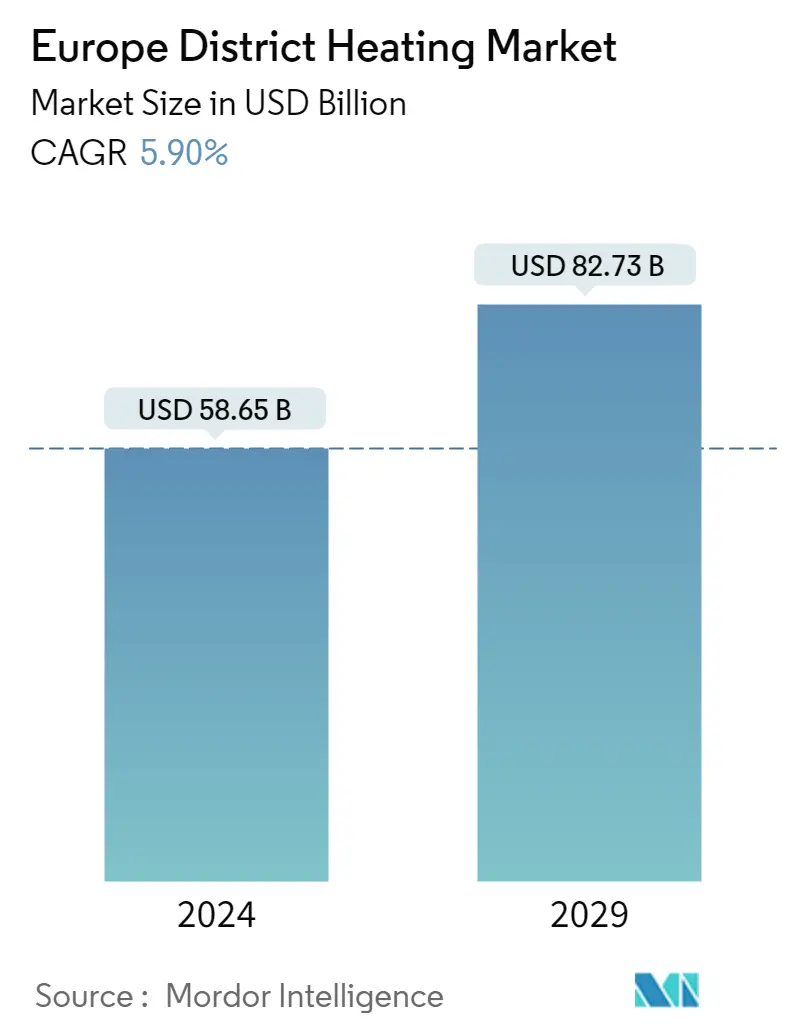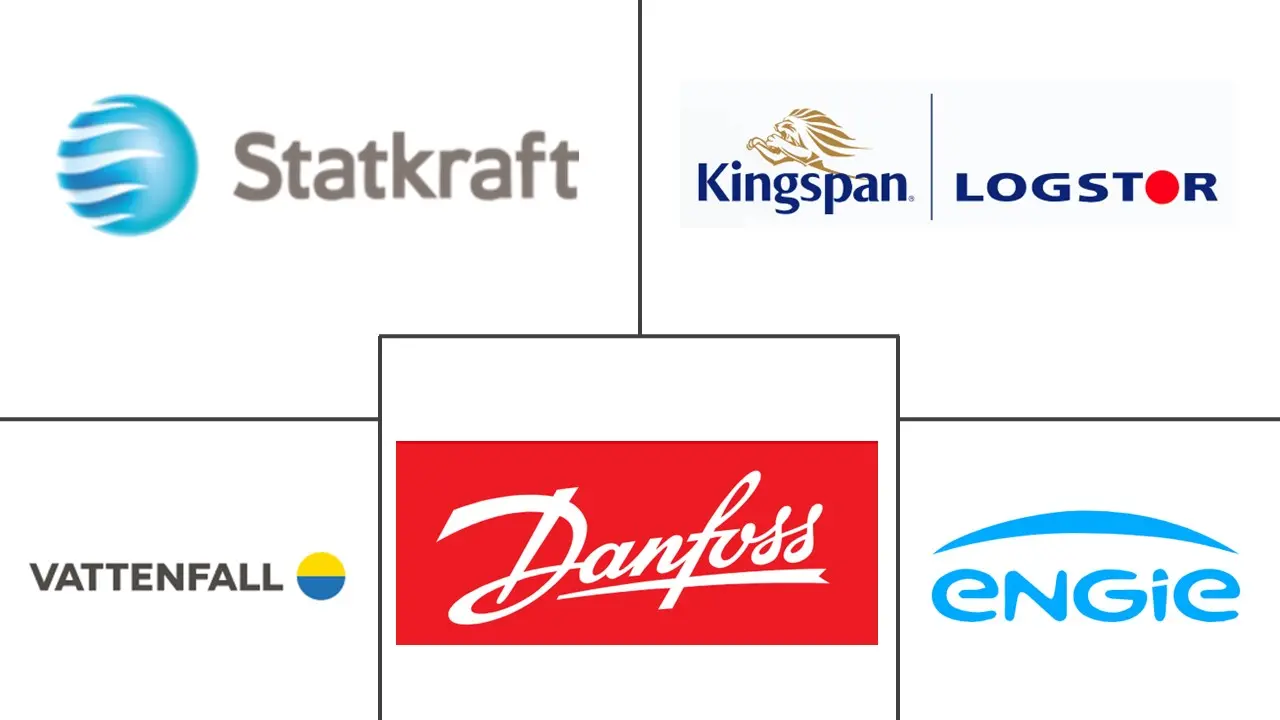Market Size of Europe District Heating Industry

| Study Period | 2019 - 2029 |
| Base Year For Estimation | 2023 |
| Market Size (2024) | USD 58.65 Billion |
| Market Size (2029) | USD 82.73 Billion |
| CAGR (2024 - 2029) | 5.90 % |
| Market Concentration | Medium |
Major Players
*Disclaimer: Major Players sorted in no particular order |
Europe District Heating Market Analysis
The Europe District Heating Market size is estimated at USD 58.65 billion in 2024, and is expected to reach USD 82.73 billion by 2029, growing at a CAGR of 5.90% during the forecast period (2024-2029).
Introducing new technologies like machine learning, IoT services, and smart meters has helped optimize the heating cycles according to the varying demands in Europe.
- A district heating system helps achieve energy efficiency and reduces the cost for both residential and commercial users. The demand for the solutions is expected to be particularly high in Europe. It is expected to see higher investments over the coming years. According to the Heat Roadmap Europe data, if the urbanization trend continues and appropriate investments are implemented, district heating could meet almost half of Europe's heat demand by 2050.
- Approximately 60 million EU (European Union) citizens are currently served by district heating, with an additional 140 million people living in cities with at least one district heating system. According to EU and the IEA reports, DH currently meets around 11-12 percent of the EU's heat demand via 6,000 district heating and cooling networks.
- The increasing focus on the shift toward renewable energy sources, instead of fossil fuels, by the governments of multiple countries across the globe is expected to offer great opportunities for innovations in the district heating market. For instance, in February 2022, the European heating market agreed to phase out fossil gas, a joint decision undertaken by NGOs and industry.
- For instance, Finland plans to increase the renewable energy share in its energy consumption to about 50 percent by 2030. Further, a medium-term climate change plan for 2030 was released. Finland plans to close coal-fired CHP plants slowly by 2030, along with financially supporting operators that switch to efficient biomass CHP and new heating technologies by 2025. It is expected to decrease the district heating CHP capacity due to the decommissioning of plants. The remaining district heating CHP plants can be converted to 100 percent biomass.
- Additionally, the increasing decarbonization initiatives across the globe, specifically in Europe, led to initiatives and programs that fuel the transition of district heating systems from fossil fuels to renewables. Moreover, Vattenfall AB has plans to decarbonize its production portfolio in the cities. The decarbonization process is expected to be implemented first, with the coal/peat phase-out by 2030, followed by the replacement of fossil gas by 2050.
- However, the installation of district heating systems often requires significant initial investment costs. This cost factor can act as a restraint on the market growth. The district heating systems may also need help in providing efficient heating solutions for small heating loads or in areas with limited space for distribution grids.
- Moreover, Russia's invasion of Ukraine has highly impacted energy and food markets across the globe, especially in Europe. Since the second half of 2021, there has been a sharp increase in energy prices in the region. The price of fuels has risen as a consequence of the Russia-Ukraine war, which has also led to concerns related to the security of the energy supply in the region. Russia's decision to suspend gas deliveries to several EU member states has further impacted the situation.
Europe District Heating Industry Segmentation
District heating provides heat to households and commercial buildings by supplying hot water through a distributive channel of insulated pipes. The resources used for heating are shifting from fossil fuels like coal and natural gas to renewable sources of energy like solar energy and geothermal energy.
The Europe district heating market is segmented by end-user (residential, commercial, and industrial) and country (Germany, France, Poland, Scandinavian Countries, Czech Republic, Austria, and the Rest of Europe). The market sizes and forecasts are provided in terms of USD value for all the above segments. The study also examines the impact of macroeconomic trends on the market and impacted segments. The study also discusses the drivers and restraints likely to influence the market's evolution in the near future. The market sizes and forecasts are provided in terms of value (USD) for all the above segments.
| By End User | |
| Residential | |
| Commercial and Industrial |
| By Country | |
| Germany | |
| France | |
| Poland | |
| Czech Republic | |
| Austria |
Europe District Heating Market Size Summary
The European district heating market is poised for significant growth, driven by the integration of advanced technologies such as machine learning, IoT services, and smart meters. These innovations are optimizing heating cycles to meet the region's varying demands, enhancing energy efficiency and reducing costs for both residential and commercial users. The market is expected to see increased investments, particularly as urbanization trends continue and governments focus on transitioning from fossil fuels to renewable energy sources. This shift is supported by initiatives like Finland's plan to increase renewable energy consumption and the European heating market's agreement to phase out fossil gas. However, the market faces challenges, including the high initial costs of installing district heating systems and the need for efficient solutions in areas with limited space for distribution grids.
The demand for district heating solutions is particularly strong in Germany, where high energy prices and a cold climate make alternative heating solutions necessary. Government regulations and initiatives, such as the Climate Action Plan 2050, are promoting the adoption of renewable energy resources in the sector, encouraging companies to develop greener solutions. The market is semi-consolidated, with major players like Vattenfall AB, Danfoss AS, and Engie SA adopting strategies such as partnerships and acquisitions to enhance their offerings. Projects across Europe, such as the low-carbon district heating system in Ireland and waste heat recovery in Germany, highlight the region's commitment to reducing carbon emissions and improving energy efficiency. Despite challenges like the impact of the Russia-Ukraine war on energy prices and supply security, the European district heating market is well-positioned for growth and innovation.
Europe District Heating Market Size - Table of Contents
-
1. MARKET DYNAMICS
-
1.1 Market Overview
-
1.2 Industry Attractiveness - Porter's Five Forces Analysis
-
1.2.1 Bargaining Power of Suppliers
-
1.2.2 Bargaining Power of Buyers
-
1.2.3 Threat of New Entrants
-
1.2.4 Threat of Substitute Products
-
1.2.5 Intensity of Competitive Rivalry
-
-
1.3 Industry Value Chain Analysis
-
1.4 The Impact of Macroeconomic Trends on the Market
-
1.5 Government Initiatives and Programs on District Heating/Cooling Transition
-
1.6 Development of District Heating Technology
-
-
2. MARKET SEGMENTATION
-
2.1 By End User
-
2.1.1 Residential
-
2.1.2 Commercial and Industrial
-
-
2.2 By Country
-
2.2.1 Germany
-
2.2.2 France
-
2.2.3 Poland
-
2.2.4 Czech Republic
-
2.2.5 Austria
-
-
Europe District Heating Market Size FAQs
How big is the Europe District Heating Market?
The Europe District Heating Market size is expected to reach USD 58.65 billion in 2024 and grow at a CAGR of 5.90% to reach USD 82.73 billion by 2029.
What is the current Europe District Heating Market size?
In 2024, the Europe District Heating Market size is expected to reach USD 58.65 billion.

